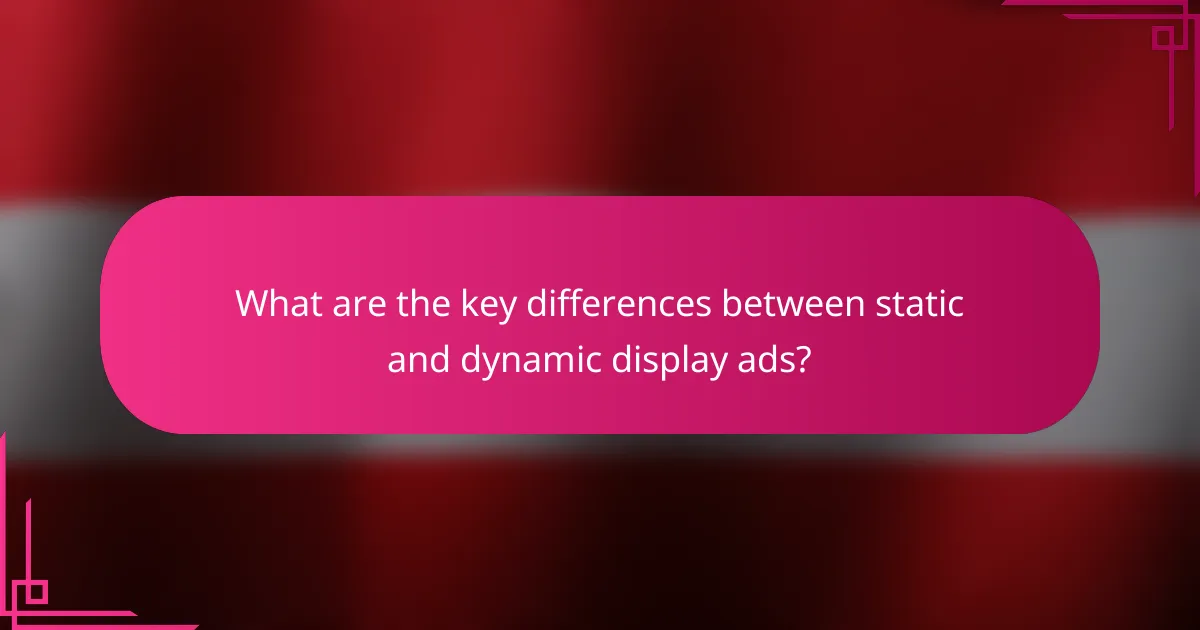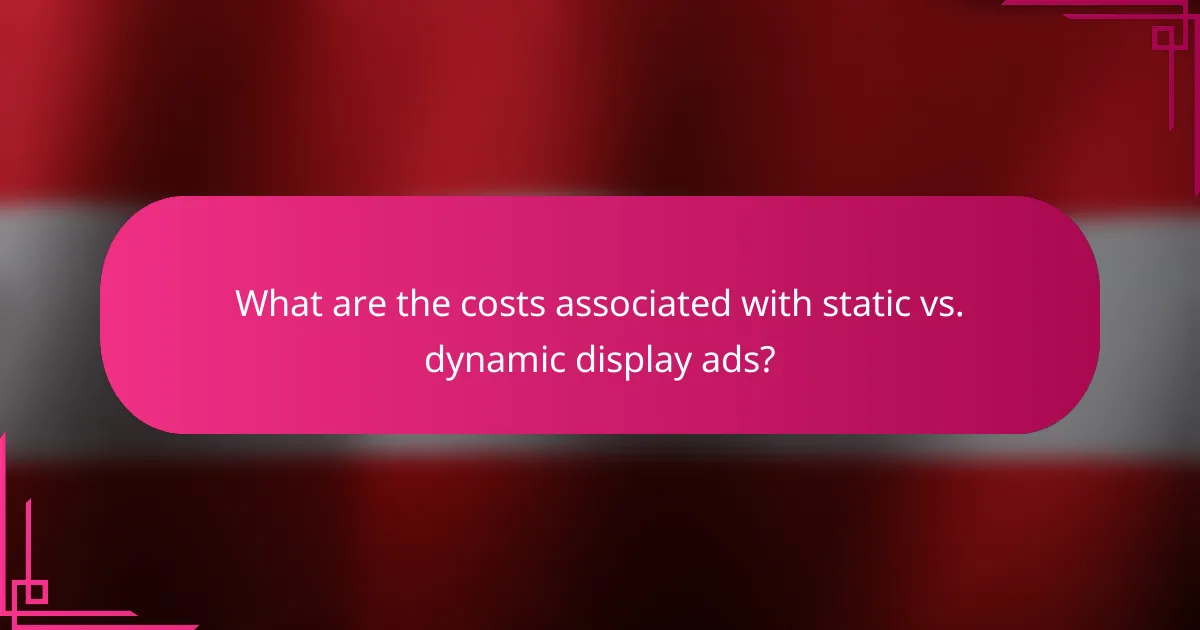Choosing between static and dynamic display ads is crucial for maximizing advertising effectiveness. Static ads are ideal for building brand awareness with clear messages, while dynamic ads excel in personalized targeting, making them perfect for retargeting campaigns. Understanding your campaign goals and audience needs will help determine which type of ad is best suited for your objectives.

Which display ad type is more effective for advertisers?
Static display ads are generally more effective for building brand awareness, while dynamic display ads excel in personalized targeting. The choice between them depends on the campaign goals and the audience’s needs.
Static display ads for brand awareness
Static display ads are simple, visually appealing images or graphics that convey a brand’s message without movement. They are effective for creating a strong brand identity and increasing recognition among potential customers. For example, a well-designed banner ad can leave a lasting impression, making it easier for consumers to recall the brand later.
When using static ads, focus on clear visuals and concise messaging. Aim for high-quality images and a strong call to action. These ads work best when placed on high-traffic websites relevant to your target audience, ensuring maximum visibility and engagement.
Dynamic display ads for personalized targeting
Dynamic display ads adapt their content based on user behavior, preferences, and demographics, making them powerful for personalized targeting. These ads can showcase different products or offers to different users, increasing the likelihood of conversion. For instance, if a user has previously browsed a specific category on an e-commerce site, dynamic ads can display related products to entice them back.
To effectively implement dynamic ads, utilize data analytics to understand your audience’s preferences. Ensure that your ad platform supports dynamic content and test various versions to see which resonates best with your audience. This approach can significantly enhance engagement and drive sales, especially in competitive markets.

When should I use static display ads?
Static display ads are best used when you want to convey a clear and straightforward message without the need for complex interactions. They are particularly effective for brand awareness and direct response campaigns where simplicity is key.
Best for simple messaging
Static display ads excel at delivering uncomplicated messages quickly. They use a single image or graphic along with minimal text to communicate a brand’s value proposition or a specific offer. For instance, a straightforward promotion like “20% off your first purchase” can be effectively conveyed through a static ad.
When crafting static ads, focus on bold visuals and concise copy. This ensures that the message is easily digestible, making it ideal for audiences who may only glance at the ad briefly.
Effective for low-budget campaigns
Static display ads are a cost-effective option for advertisers with limited budgets. Since they do not require the same level of production as dynamic ads, costs can be significantly lower. You can create visually appealing static ads using basic design tools or templates, which reduces overall expenses.
For low-budget campaigns, prioritize clarity and impact in your design. Consider allocating funds towards strategic placements on websites that align with your target audience, maximizing visibility without overspending.

When should I use dynamic display ads?
Dynamic display ads are best used when you want to deliver personalized content to users based on their previous interactions with your brand. They are particularly effective for retargeting campaigns and can significantly enhance engagement by showcasing relevant products or services to potential customers.
Ideal for retargeting strategies
Dynamic display ads excel in retargeting strategies by reminding users of products they viewed or added to their cart but did not purchase. This approach leverages user behavior data to create tailored ads that resonate with individual preferences, increasing the likelihood of conversion.
To implement effective retargeting, ensure your ad platform can track user interactions and serve personalized ads accordingly. Consider segmenting your audience based on their engagement level, such as recent visitors versus those who haven’t interacted in a while, to optimize your ad delivery.
Useful for product catalog promotions
Dynamic display ads are particularly useful for promoting extensive product catalogs, as they can automatically showcase a variety of items based on user interests. This automation allows advertisers to display the most relevant products without manually creating individual ads for each item.
When using dynamic ads for catalog promotions, ensure your product feed is well-organized and up-to-date. Highlight seasonal items or special offers to capture attention. For example, if you run a clothing store, you could feature new arrivals or discounts on popular items tailored to user preferences.

What are the key differences between static and dynamic display ads?
Static display ads consist of fixed images that do not change, while dynamic display ads automatically adjust their content based on user data and behavior. Understanding these differences can help marketers choose the right ad type for their campaigns.
Static ads are fixed images
Static ads are unchanging visual elements that typically feature a single image, text, and a call to action. They are straightforward and easy to create, making them suitable for brand awareness and simple promotional messages. For example, a static ad might showcase a product with a clear price and a direct link to purchase.
While static ads can be effective, they may not engage users as deeply as dynamic ads. Their fixed nature means they cannot tailor messages to individual user preferences or behaviors, which can limit their effectiveness in reaching diverse audiences.
Dynamic ads adapt content based on user data
Dynamic ads utilize algorithms to change their content based on user interactions, demographics, and browsing history. This personalization can significantly enhance engagement by displaying relevant products or services to each viewer. For instance, a dynamic ad might show a user a specific pair of shoes they viewed previously, along with similar items.
When using dynamic ads, it’s crucial to have robust data collection and analysis systems in place. This ensures that the ads are not only personalized but also compliant with data protection regulations. Marketers should regularly test and optimize dynamic ad content to maximize performance and conversion rates.

How do static and dynamic ads perform in major US markets?
In major US markets, static ads typically achieve higher visibility, while dynamic ads tend to generate better engagement rates. The choice between the two depends on your campaign goals and target audience.
Static ads show higher visibility
Static ads are often more visually striking and can capture attention quickly, making them effective for brand awareness. They usually feature bold images and concise messaging that can be easily understood at a glance.
For example, a well-designed static banner ad can stand out on a webpage, leading to higher impressions. Advertisers should consider using static ads when the goal is to create a strong brand presence or convey a straightforward message.
Dynamic ads yield better engagement rates
Dynamic ads personalize content based on user behavior, which can lead to improved engagement. By showing relevant products or services tailored to individual preferences, these ads can significantly increase click-through rates.
For instance, an e-commerce site might display dynamic ads featuring items a user has previously viewed, encouraging them to return and make a purchase. Businesses should leverage dynamic ads when aiming to drive conversions and foster customer relationships.

What are the costs associated with static vs. dynamic display ads?
The costs associated with static and dynamic display ads vary significantly based on production, technology, and ongoing management. Static ads generally incur lower initial costs, while dynamic ads may require a larger investment in technology and data integration.
Static ads typically have lower production costs
Static display ads are usually simpler to create, involving basic graphic design and minimal animation. This simplicity translates to lower production costs, often ranging from a few hundred to a couple of thousand dollars, depending on the design complexity.
For businesses with limited budgets, static ads can be a cost-effective solution. They are particularly suitable for campaigns with straightforward messaging or branding goals, where high-quality visuals can still make a strong impact.
Dynamic ads may require higher investment in technology
Dynamic display ads utilize advanced technology to deliver personalized content based on user behavior and preferences. This requires a more significant upfront investment in software and data management systems, potentially costing thousands of dollars to set up.
Additionally, ongoing costs for dynamic ads can include data analytics and optimization services. Businesses should consider these factors when deciding between static and dynamic ads, as the return on investment can vary based on campaign goals and audience targeting.

What tools can help create static and dynamic display ads?
Several tools can assist in creating both static and dynamic display ads, each catering to different needs and skill levels. Popular options include graphic design platforms for static ads and advertising networks for dynamic campaigns.
Canva for static ad design
Canva is a user-friendly graphic design tool that allows users to create visually appealing static ads without needing extensive design skills. It offers a wide range of templates, images, and fonts, making it easy to customize ads to fit specific brand guidelines.
When using Canva, consider the dimensions required for your ad placements, such as 300×250 pixels for medium rectangles or 728×90 pixels for leaderboards. This ensures your ads are optimized for various platforms.
Google Ads for dynamic ad campaigns
Google Ads is a robust platform for managing dynamic ad campaigns that automatically tailor content based on user behavior and preferences. This tool allows advertisers to create responsive display ads that can adjust images, headlines, and descriptions to enhance engagement.
To effectively use Google Ads for dynamic ads, ensure your product feed is well-structured and updated regularly. This will help in delivering relevant ads to the right audience, increasing the chances of conversion.
